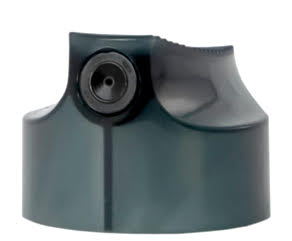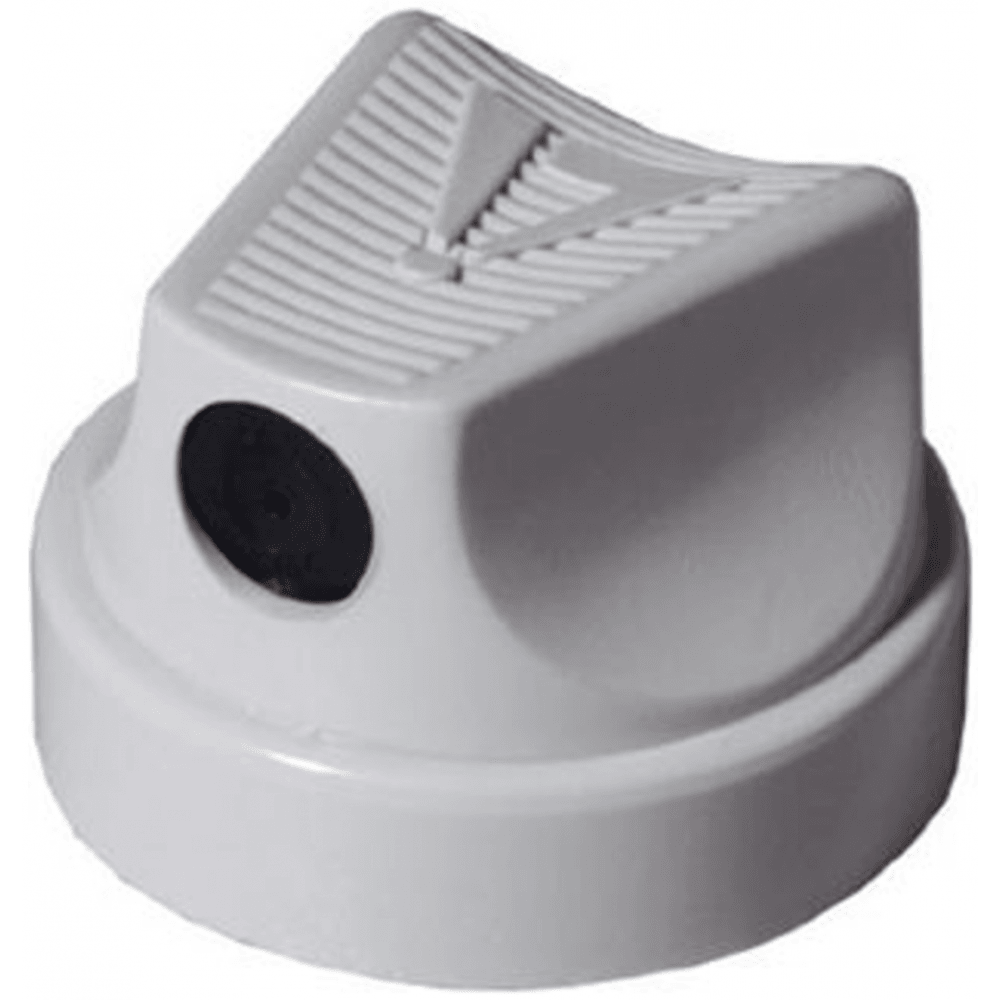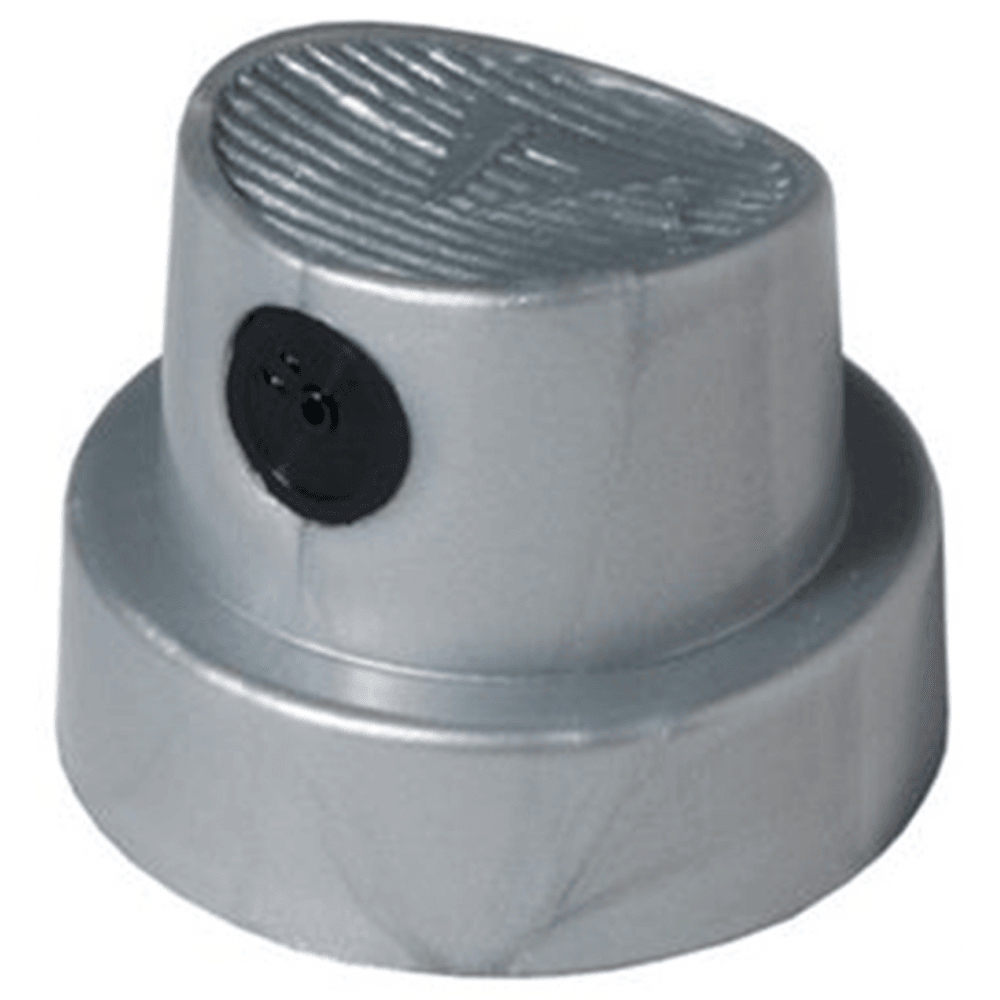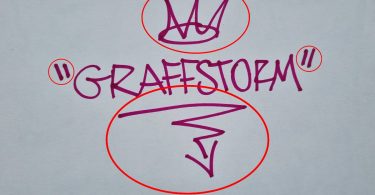Whether you’re a graffiti head or a fine art muralist, spray paint caps unite every aerosol artist.
So having a strong understanding of how they work and being able to tell the difference between each is essential.
If not, you might find yourself getting to the wall only to realise you packed the wrong caps. And filling in an entire piece with a skinny cap is not fun. Trust me – if you’ve been there, you’ll know.
This guide aims to guarantee that you’ll never be in this situation.
So you’ll learn everything from what a spray paint cap is, what the different types are, how wide they spray and when best to use them. Plus, how to get the most uses out of your caps.
Let’s get into it.
Different types of spray paint caps
Just like there’s no one-size-fits-all for paintbrushes, the same is true for spray paint caps.
Caps can be split into 6 different categories depending on the width of the line they produce and/or the different effects they create.
The main categories are super skinny caps, skinny caps, medium caps, fat caps, super fat caps and special caps.
1. Super Skinny Caps
Super skinny caps are used to create very fine lines, allowing for complex and intricate details to be achieved.
For small projects like canvas painting or arts and crafts, super skinny caps may be the best option. They also may be used by street artists when painting detailed portraits, or graffiti artists for complex fill-ins and superfine outlines.
You may want to consider using low pressure spray paint when using super skinny caps.
This is because lower pressure spray paint allows for better can control and reduces the risk of paint dripping or splattering – which is essential for fine lines and complex details.
Here are a few examples of popular super skinny caps:
Note: The caps featured in this guide are male caps that fit most professional spray paint cans designed for art.
Montana Level 1
The skinniest cap in Montana’s Level Cap range and the ultimate cap for precision. Quite possibly the skinniest cap on the market.
Spray width: 0.4 – 1.5cm

MTN Super Skinny
MTN’s answer to super skinny lines. Perfect for complex details and fine outlines. Works great with MTN 94 spray paint.
Spray width: 0.4 – 2cm

Molotow Super Skinny
Molotow’s skinniest cap. A good choice for clean lines and fine details. Designed for Molotow Premium, but works perfectly on most cans.
Spray width: 0.4 – 2cm

2. Skinny Caps
Skinny caps are one of the most popular types of spray paint caps.
You’ll find that skinny caps come stocked on most low-pressure premium paints like Montana Gold, MTN 94 and Loop.
They’re one of the most versatile caps as experienced aerosol artists can manipulate these to produce both very fine lines all the way to skinny-medium lines.
For beginner graffiti artists, skinny caps are one of the best caps for learning how to control a can and for improving linework. Although this will depend on the graffiti style they’re going for.
Here’s a look at some of the most popular skinny caps:
Montana Level 2
The 2nd skinniest cap in Montana’s Level Cap range. Use to achieve fine lines and to perfect smaller details.
Spray width: 0.6 – 2.5cm

MTN Skinny Pro
Designed to work best with low to medium pressure cans. Super popular cap that’s one of Europe’s favourite skinny caps.
Spray width: 0.5 – 2.5cm

Banana Universal
One of the most popular skinny caps across the globe. Perfect for detailed work and fits on all premium paint brands.
Spray width: 0.5 – 3cm

Kobra Red Skinny
Kobra’s most iconic skinny cap. Comes stock on Kobra HP paint. High precision and versatility for skinny-medium lines.
Spray width: 0.5 – 3cm

Molotow Standard Skinny
Molotow’s signature standard skinny cap. Works perfectly with most spray cans to produce fine, old school lines.
Spray width: 0.5 – 2.5cm

Loop Skinny
Comes fitted on Loop Colours and works with most premium paints. Great for fine-medium lines and a personal favourite for outlining.
Spray width: 0.5 – 3cm

3. Medium Caps
Medium caps sit between skinny and fat caps.
They’re able to produce both thin lines and medium lines, depending on how far they’re sprayed from the wall.
It’s also where we begin to see soft cap effects, for example on the Montana Level 3 and Molotow Blue Dot listed below.
Soft caps produce a softer, more dusty line which makes them great for fading or producing softer details with less sharpness.
Here are a few popular medium caps:
Montana Level 3
Montana Level 3 is a soft cap for medium average spray width. Compatible with all other premium paint brands.
Spray width: 1 – 4cm

Lego Cap
The Lego Cap is another very popular cap, especially in the US. Extremely versatile, it’ll work on all European premium spray cans.
Spray width: 1.5 – 5cm

German Outline
The German Outline cap is great for – you guessed it – outlines. But also excellent overall for detailed work and medium lines.
Spray width: 1 – 4cm

Kobra Grey Banana Cap
The Grey Banana Cap is similar to the German Outline and produces skinny-medium sized lines. A popular cap for graffiti writers.
Spray width: 1 – 4cm

Molotow Blue Dot Soft Cap
The Blue Dot Soft Cap produces a soft, dusty style line. Great for fading and highly versatile for thin and wide lines.
Spray width: 1 – 4.5cm

4. Fat Caps
Along with skinny caps, fat caps are another very common type of spray paint cap.
They’re used to fill in large areas and to create fat lines and flares. Although with good can control, skilled artists can also achieve thin lines with fat caps.
The NY Fat Cap is easily the most iconic of all fat caps. It gets its name from the birthplace of graffiti and is the go-to cap for graffiti writers that need fat lines.
Because fat caps have high paint output, be warned that they can drain the contents of a spray can very quickly. This means they’re not great for being economical with paint.
If painting quickly is your style though, then these are the caps you need:
NY Fat Cap
The NY Fat Cap is one of the most iconic spray paint caps. Extremely popular with graffiti writers for producing fat lines and flares.
Spray width: 2 – 6cm

Montana Level 4
Montana’s 4th Level Cap. Great for wide lines although has a lower output with a soft finish. For finer lines, spray from a close distance.
Spray width: 3 – 8cm

Montana Level 5
One level up from the Montana Level 4, the Level 5 has a much higher output and is a much more traditional fat cap.
Spray width: 4 – 12cm

Silver Fat Cap
Another classic fat cap and a favourite for graffiti writers. Great for quick fill-ins and fading. Not great for fine lines – unless you’re a pro.
Spray width: 4 – 12cm

Yellow Fat Cap
The Yellow Fat Cap is extremely high and fast paint output. Best used with 600ml cans for painting super quickly.
Spray width: 3 – 10cm

MTN Hardcore Fat Cap
Designed as a fat cap solution for MTN Hardcore. This cap produces a very wide line but depletes spray cans very fast.
Spray width: 4 – 12.5cm

5. Super Fat Caps
Super fat caps are like fat caps but on steroids.
Although they’re some of the hardest caps to control, they’re great for filling in huge areas where achieving perfect lines isn’t an issue. Think filling in huge silver chrome graffiti pieces or painting murals that take up the whole wall.
Just like fat caps, super fat caps will drain your spray can fast. So be careful with these if you’re running low and need to preserve paint.
Compared to other sized caps, there’s not a huge number of super fat caps out there as they have more limited use.
Nonetheless, here are a few popular super fat caps you can easily find online:
Montana Level 6
Montana’s final and fattest cap in their Level Cap range. This ultra-wide fat cap is one of the fastest for filling in large areas.
Spray width: 5 – 20cm

Astro Fat Cap
The Astro Fat Cap is one of the widest caps on the market and is notorious for its super high output. Use with caution.
Spray width: 5 – 25cm

Molotow Pink Dot
Perfect for covering large areas in seconds. It comes stock on Molotow’s Burner Chrome, so you know its gotta be wide.
Spray width: 5 – 25cm

Super Booster Cap
Only for use on 600ml cans or bigger. The Super Booster produces wide calligraphy style lines with extremely high output.
Spray width: 5 – 35cm

6. Special Caps
Special caps have unique qualities to the other caps we’ve looked at so far as they allow artists to achieve specific effects or have unconventional uses.
They’re usually aimed at a specific style of graffiti or art, so the everyday aerosol artist might not come across these too often.
It’s definitely worth giving them a try if you have the chance, though. Here are a few popular special caps:
Needle Cap
Needle caps have a very small spray width and produce a very concentrated line with a dusty exterior.
Spray width: 0.4 – 1.2cm

Calligraphy Cap
Calligraphy caps produce wide lines in a similar style to calligraphy pens. Twist the nozzle to make lines either vertical or horizontal.
Spray width: 1.5 – 8cm

Stencil Cap
Stencil caps produce the skinniest lines possible. Unlike other caps, it sits on the rim of the can. Use with low pressure paint and a skinny cap.
Spray width: 4 – 6mm

Transfer Cap
A super specialised cap. The Transfer Cap lets you transfer spray paint from one can to another. Great for combining scrap cans.
Spray width: N/A

Tube Cap
There might not be a crazier cap than this. The tube cap hit the market in early 2023 and has become iconic for letting artists reach serious heights. Think needle cap on steroids.
Spray width: N/A

What are spray paint caps?
Spray paint caps (also known as nozzles and nibs) are small plastic tips that attach to the top of spray paint cans. Once pressed, caps release pressure from a spray can through the valve and fire out the paint.
Spray paint caps come in many different shapes, sizes and colours. For artists, they’re best thought of as similar to paintbrushes. Different caps allow for different effects like fine lines and thick lines – just like different-sized paintbrushes.
It’s important that artists use the right caps because they can impact the outcome of their work.
For example, an artist painting complex details on a small canvas would need a cap that sprays a skinny line. Whereas a graffiti artist who wants to paint a big piece quickly will need a fat cap for maximum coverage.
Most professional spray paints for art come with caps installed on them. However, they may not always be the size the artist needs, so they’ll sometimes need to swap them out for a different cap.

What spray paint cap should I use?
The type of cap you should use depends entirely on your style of art.
For arts and crafts hobbyists painting things like a small canvas or small figurines, super skinny to skinny caps will work perfectly.
If you’re painting the background of a big canvas or painting bigger objects, a medium or fat cap might be better.
Street artists and muralists may choose to use every type of spray paint cap depending on their art style. Although as a rule of thumb, fat caps are best for painting large areas.
Graffiti writers may also choose any cap depending on their style. But if they want to be quick whilst still being able to go big and bold, fat or super fat caps are the best to use.
The best way to find your perfect cap is by trying out different sizes. We’d recommend picking up something like the Montana Tryout Cap Set so you can test some of the most popular caps out.
Can spray paint caps be reused?
Yes, caps can be reused. But they can also get clogged with paint easily, especially without proper care. Here are a few tips to get the most uses out of your spray paint caps:
- Always spray out your cans after use. Do this by turning the can upside down and spraying it until no more paint comes out. This not only unclogs the cans valve so it can be used later but also unclogs the cap so it can be used again.
- Use a cap cleaner spray. A cap cleaner like the Montana Acetone Spray can be used to unclog spray paint caps. Just fit the clogged cap onto the acetone can and spray until it runs clear. Easy.
- Soak clogged caps in acetone. Soaking clogged caps in acetone for between 3 – 6 hours (or overnight for best results) can unblock them. To do this, put the clogged caps in a small glass jar and fill it with a cheap 100% acetone solution like nail polish remover. Completely submerge the caps in the solution until the paint has been removed.
Got a favourite cap or an expert tip to keep your caps fresh? Drop a comment and let me know.





After 5 years without painting (wife an kids) I’ve begun to awaken from my slumber. Missing late nite walks in the train yards an warehouse district with the crew, or solo adventures climbing into the heavens. My last trip was with my girl (now wife) under i5 overpass.
Yet, now I feel I must get back out an start painting again…it’s a need to do!
The paints an cans haven’t changed much, however the caps have evolved a bit more then half a decade ago. This read was enlightening. Was literally about to make a purchase from the old Graff shop in Seattle, then I saw this in my Google news feed. And I will be updating my cart asap 😉
Much appreciation to the level of detail an depth to this article.